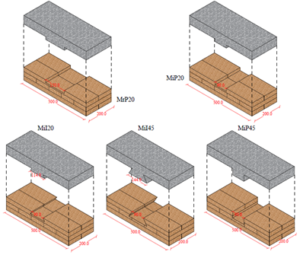Responsible partners: SerQ (Portugal) and Cesefor (Spain)
Description: The main goal of Experiment nº3 is to assess the mechanical performance of CLT-concrete connections’ behaviour with local softwood species (Maritime pine, Radiata pine and Scots pine). The experimental campaign was established based on:
- Theoretical design based on codes (e.g. CEN/TS 19103:2021);
- Production of CLT elements at laboratory facilities;
- Concrete pouring on CLT elements;
- Double shear push-out tests following EN 26891.
As the scope of the Eguralt project is the promotion of mid-rise timber buildings in the SUDOE area, it was decided to focus the study on local softwoods for CLT production, having several variables on the experimental campaign:
- Species used: i) Maritime pine, ii) Radiate pine and iii) Scots pine;
- Notch configuration:
- Depth of the notch: i) 20 mm and ii) 45 mm;
- Length of the notch: i) 150 mm (reference) and ii) 90 mm;
- Angle with axis: i) perpendicular and ii) inclined.
- Concrete type: i) in-situ, ii) prefabricated and iii) with steel fibres.
Figure 1 shows some of the configurations adopted for maritime pine specimens with in-situ concrete. The tests followed a double-shear test configuration as shown in Figure 2.

Figure 1 – Configuration of CLT-concrete specimens for maritime pine with concrete cast in-situ

Figure 2 – Double-shear test layout adopted
Currently, some results are being processed to produce more reliable results (in-situ concrete; prefabricated concrete; steel fibres at concrete). Nevertheless, the main results achieved so far with in-situ concrete are described below:
- Highest load-carrying capacity was achieved for reference specimens (MrP20);
- A ductile behaviour was observed only at reference specimens, combining several failure modes (Figure 3):
- Crush of timber as well as concrete;
- Shear of timber and shear of concrete.
- The notch depth did not influence load-carrying capacity. However, a decrease was observed for slip modulus;
- Shear of timber was observed at inclined notch specimens;
- Shear of concrete was the most common failure mode;
- Radiata pine specimens had the highest slip modulus.

Figure 3 – Reference specimen during loading procedure showing shear of timber and crush of timber
The Figure 4 shows several specimens during the loading procedure and after a collapse.

Figure 4 – Radiata pine with a perpendicular notch (left) and maritime pine with an inclined notch – 45 mm depth (right)
These results are being considered within several outputs, such as:
- International conferences:
- Moltini, G., Cabrera, G. and Baño V. “Structural yield of a pedestrian bridge made of CLT-concrete, connected by screws and by notches”. 4th International Conference on Timber Bridges – ICTB 2021, 9th – 12th May 2022, Biel, Switzerland. (published)
- Albino, C., Martins, C., Ferreira, C., Augusto, R. Dias, A. M. P. G. “Mechanical behaviour of notch connection for maritime pine CLT-concrete composite”. WCTE2023 – World Conference on Timber Engineering, Oslo, Norway (accepted for full paper).
- Thesis:
- Augusto, R. “Modelação numérica e avaliação experimental de soluções mistas CLT- betão” (“Numerical modelling and experimental evaluation of CLT-concrete composite solutions”). Universidade de Coimbra. Master Thesis (to be delivered soon);
- Moltini, G. “Análisis numérico y experimental de forjados CLT-Hormigón” (“Numerical and experimental analysis of CLT – Concrete slabs”). Universidad Politécnica de Madrid. PhD Thesis (to be delivered in 2024).




